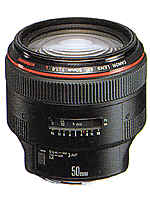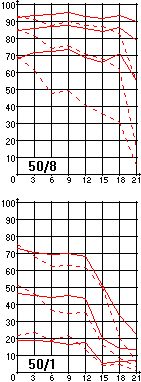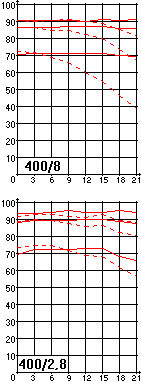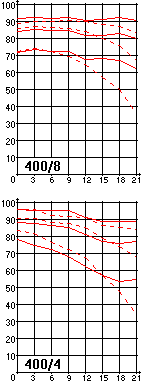www·photodo·com(下面简称Photodo)可能是使用MTF方法测试镜头内容最多的网站了,关于如何理解MTF曲线的意义,这里先不谈。
下面这段英文是Photodo给出的如何看他们的测试结果的说明:
Understanding the MTF graphs, numbers and grades
Understanding the MTF graphs, numbers and grades We have been testing lenses with Hasselblads Ealing MTF equipment since 1991. All MTF reports are made with the same equipment and by the same operator (Per Nordlund at Victor Hasselblad AB).
(说明:这些结果是从1991年开始测试的,使用Hasselblads的Ealing MTF测试设备,均由同一个人Per Nordlund来操作测试,这个人在Victor Hasselblad AB公司干活的。)
So far we have tested lenses only at infinity.
We measure MTF at 10, 20 and 40 lp/mm, where 10 lp/mm (line pairs/ mm) means 10 black lines with 10 white lines in between, for each millimeter.
The lens with the highest MTF in our tests (so far) is the Canon EF 200/1,8L USM.
Photodo test result: 4,8
Higher is better. 4,8 is the grade on a scale going from 0 to 5. The grade is based on the average weighted MTF for the lens. No other variables, such as distortion, flare, or ghosting are taken into account. We chose 0,88 for a grade of 4,8 to make sure that we will never hit the "roof" (>5). See more at Average Weighted MTF: 0,88 below.
(说明:最高分是5分。)
Effective focal length: 195 mm
Often the real focal length differs from the one given by the manufacturer. 195 mm is the length we measured with the Ealing.
Weighted MTF for 200 mm: f1,8 0,82, f2,8 0,89, f4 0,90, f8 0,87
Higher is better. MTF is measured 0, 3, 6, 9, 12, 15, 18, and 21 mm from the image center (on axis), at 10, 20 and 40 lp/mm, in two different directions (sagital and tangential). That is all together 48 measurements at each focal length and each f-stop. Rather than listing all these numbers we calculate a weighted average number for each f-stop of all lenses and each focal length of zoom lenses. The center of the image is more important than the edges, and 10 lp/mm is more important than 20 and 40.
(说明:这里说明加权MTF分数如何得出,从画面中心开始,在0、3、6、9、12、15、18、21mm处分别测量10、20、40lpm的MTF切向与径向的高度,这样在每个焦距和每个光圈处总共就有了48个数据,然后按加权数来计算出分数,加权数强调中心,也强调10lpm,可惜的是没有给出权重。)
The maximum MTF is 1,0, but due to optical imperfections and diffraction, a perfect score is impossible to reach at these line frequencies.
The MTF at large apertures (f1,0 - f2,8) is limited by optical imperfections (with major differences between lenses). At small apertures (f11 - f32+) MTF is limited by diffraction (with minor differences between lenses). For example the Canon EF 200/1,8L USM has its peak at f4.
We don't measure beyond f8 because lens performance at small apertures is limited more by diffraction than by optical quality. At very small apertures all lenses are about equally bad.
Average Weighted MTF: 0,88
Higher is better. When we report an average MTF number for all f-stops at one focal length we use f4 (or wide open, if f4 is not attainable) and f8. Most lenses have their highest MTF at f8. High-speed lenses almost always have a very low MTF at full aperture. That is why we decided to use f4 and f8 as standard apertures. Since MTF for f8 is slightly more important than for f4, we assign weights of 60% for f8 and 40% for f4. In the case of zoom lenses, we report the weighted average MTF at each measured focal length.
Weighted MTF 10 lp/mm: 0,94
Higher is better. 10 lp/mm is important for evaluating the overall contrast and resolution when making small enlargments (10 x 15 cm or 4 x 6 inches).
Weighted MTF 40 lp/mm: 0,71
Higher is better. 40 lp/mm is important only when you intend to make large prints of high quality. If you are going to use the lens with fine grain film, the camera on a tripod, and make big enlargements, then it is important to choose a lens with a high MTF at 40 lp/mm.
Max distortion: -1,1 %
Closer to zero is better. Distortion is when a straight line near the edge appears curved in the image. If the line curves out in the middle, it is due to negative (barrel) distortion of the lens。
Positive or pincushion distortion is when straight lines curve inwards in the middle.
The graphs
The graphs show MTF in percent for the three line frequences of 10 lp/mm, 20 lp/mm and 40 lp/mm, from the center of the image (shown at left) all the way to the corner (shown at right).
The top two lines represent 10 lp/mm, the middle two lines 20 lp/mm and the bottom two lines 40 lp/mm.
The solid lines represent sagital MTF (lp/mm aligned like the spokes in a wheel). The broken lines represent tangential MTF (lp/mm arranged like the rim of a wheel, at right angles to sagital lines).
On the scale at the bottom 0 represents the center of the image (on axis), 3 represents 3 mm from the center, and 21 represents 21 mm from the center, or the very corner of a 35 mm-film image.
Separate graphs show results at f8 and full aperture. For zoom lenses, there are graphs for each measured focal length.
在Photodo上每支镜头的表示如下:
|
Canon EF 50/1,0L USM |
|
Lens mount: Canon EF
Diameter: 91,5 mm
Length: 81,5 mm
Weight: 985 g
Filter mount: 72
Lenses/Groups: 11/9
Diaphragm blades:
Max Aperture: 1
Min Aperture: 16
Close Focus: 0,6 m
Misc: AF, Single, Built-in motor (USM/SW)
Comments: |

|
|
Photodo test result: 3,9
Effective focal length: 52
Weighted MTF for 50 mm: f1 0,46, f1,4 0,55, f2 0,66, f2,8 0,74, f4 0,78, f8 0,81
Average Weighted MTF: 0,80 Grade: 3,9
Weighted MTF 10 lp/mm: 0,88
Weighted MTF 20 lp/mm: 0,76
Weighted MTF 40 lp/mm: 0,55
Distortion: % - % |

|
这些数据表明EF 50/1.0L USM这支镜头的测试结果如下:
1、实测焦距为52mm;
2、各档光圈的加权MTF值为:f1--0.46;f1.4--0.55;f2--0.66;f2.8--0.74;f4--0.78;f8--0.81;如何得来不知道;
3、10lpm的加权MTF值为:0.88;如何得来也不知道;
4、20lpm的加权MTF值为:0.76;如何得来也不知道;
5、10lpm的加权MTF值为:0.55;如何得来也不知道;
6、畸变没测试;
7、最终的平均加权MTF值为0.80,对应的得分为3.9。
我们现在来推导一些数据:
A、从2里面的6个数据,得出平均数为0.6667;
B、从3、4、5里面的3个数据,得出平均值为0.73;
现在的问题是:我们不知道这支镜头最后的平均加权MTF值(Average Weighted MTF)0.80是如何得来的!
现在我们再能够做的事情是:
就算这0.80是以一种合理的方式给出,那么0.80所对应的3.9是如何得来的?
现在看看几支EF镜头的平均加权MTF值和分数的对应关系:
|
镜头 |
平均加权MTF值 |
最终得分 |
换算差值 |
应该得分 |
|
EF 20-35/3.5-4.5 USM |
0.76 |
3.4 |
4.2 |
3.6 |
|
EF 50/1.0L USM |
0.80 |
3.9 |
4.1 |
4.0 |
|
EF 70-200/2.8 L USM |
0.82 |
4.1 |
4.1 |
4.2 |
|
EF 400/2.8 L IS USM |
0.84 |
4.4 |
4.0 |
4.4 |
|
EF 400/2.8L II |
0.85 |
4.4 |
4.1 |
4.5 |
为了找出其中的一些对应规律,按系列方法来计算换算差值:
平均加权MTF值X10-最终得分
从这些结果中有下列疑问:
1、粗看,似乎随着焦距不断增加,换算差值越来越小,但是EF 400/2.8L II的出现,打乱了这个规律;但为什么换算差值会变化呢?如果将换算差值固定为4.0,那么这5支镜头的得分应该是上表的最后一列,显然比Photodo原来给出的要高些。
2、EF 400/2.8L II的平均加权MTF值是0.85,最终得分是4.4;而EF 400/2.8 L IS USM的平均加权MTF值是0.84,最终得分也是4.4,这奇怪吗?
再看看Nikkor镜头里
|
AF 24/2.8 |
3.7 |
|
MF 24/2.8 |
3.9 |
|
AF 85/1.8D |
4.0 |
|
AF 85/1.8 |
4.2 |
|
AF 28-70/3.5-4.5D |
2.8 |
|
AF 28-70/3.5-4.5 |
3.0 |
这些镜头里都是成对的,光学结构都是一样的,但是得分结果都是相差0.2,如果不是测试样本出了问题,那么就可以得出一个结论:
相差0.2分的镜头质量都是同样的!
我们再比较两支EF 400/2.8L镜头的MTF曲线,如果不懂MTF的原理,只要看那些红线:越高越平,就越好!
显然:EF 400/2.8L II在f/2.8时的表现比EF 400/2.8L IS在f/4的表现还要好!
所以Photodo给出的平均加权MFT值是前者为0.85后者为0.84,还是合理的;但是最终都给出4.4分,就已经看不出这些差别了。
|

EF 400/2.8L II |

EF 400/2.8 L IS USM |
综上所述,我们可以大胆地预测:Photodo给出最终得分相差0.3分的,都可以认为是同等质量的镜头。
在这里,再次表述本人对Photodo测试结果的看法:
1、Photodo的测试是众多测试方法的一种;
2、Photodo的测试是针对对焦距离在无限远而进行的,显然对具有近距离浮动镜片校正的镜头不利;这个说法的基础是:没有任何一支镜头在任何对焦距离都是表现为最优的,镜头是折中的产品;
3、尽管有第2点不足,但是从MTF曲线上还是能看出某支镜头的优劣的,MTF是评判镜头优劣一个重要方法;
4、Photodo给出的最后得分来历不明,而且具有某种随意性,所以可行度不高。
如果各位想从Photodo上了解某支镜头的优劣,应该看它的MTF曲线,而不是最终得分!
|